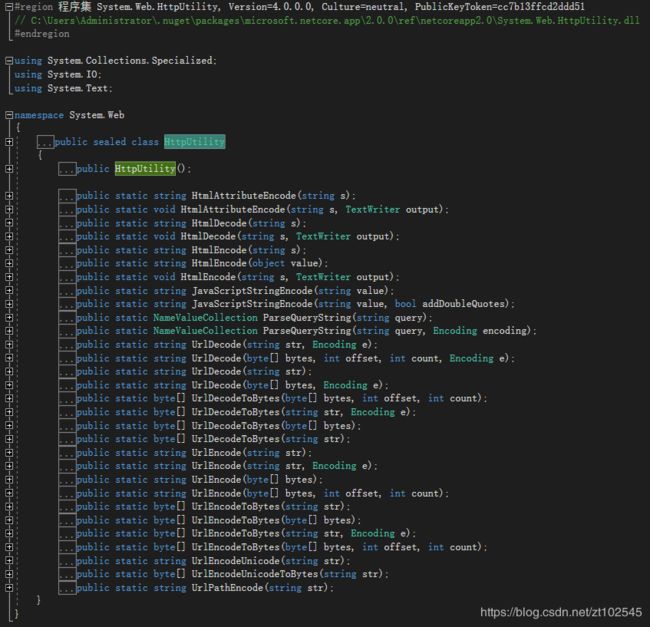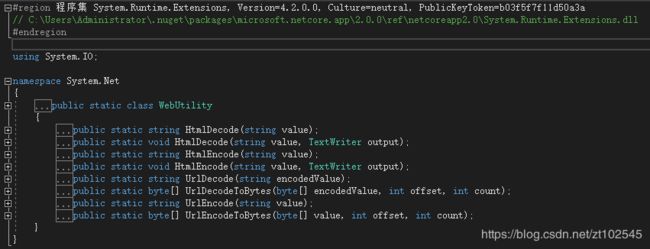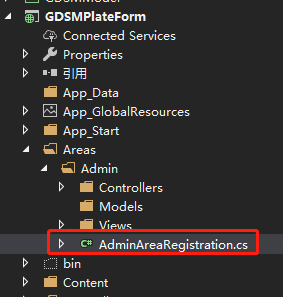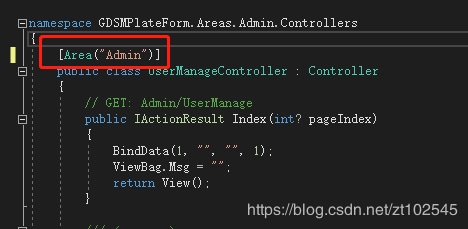目录
1.获取请求的参数
2.获取完整的请求路径
3.获取域名
4.编码
5.文件上传的保存方法
6.获取物理路径
7.返回Json属性大小写问题
8.webconfig的配置移植到appsettings.json
9.设置区域块MVC的路由器和访问区域块的视图
10.NetCore访问静态资源文件
11.MVC调用子页视图
12.过滤器
13.使用session和解决sessionID一直变化的问题
14.MD5加密
15.Path.Combine()
16.DateTime
1.获取请求的参数
NET Framework版本:
-
Request[
"xxx"];
-
Request.Files[
0];
NET Core版本:
-
Request.Form[
"xxx"];
-
Request.Form.Files[
0];
2.获取完整的请求路径
NET Framework版本:
Request.RequestUri.ToString();
NET Core版本:
-
//先添加引用
-
using Microsoft.AspNetCore.Http.Extensions;
-
//再调用
-
Request.GetDisplayUrl();
3.获取域名
NET Framework版本:
HttpContext.Current.Request.Url.Authority
NET Core版本:
HttpContext.Request.Host.Value
4.编码
NET Framework版本:
-
System.Web.HttpContext.Current.Server.UrlEncode(
"")
-
"%3cli+class%3d%22test%22%3e%3c%2fli%3e"
-
System.Web.HttpContext.Current.Server.UrlDecode(
"%3cli+class%3d%22test%22%3e%3c%2fli%3e")
-
""
NET Core版本:
-
//两种方法,建议用System.Web.HttpUtility
-
System.Web.HttpUtility.UrlEncode(
"");
-
"%3cli+class%3d%22test%22%3e%3c%2fli%3e"
-
System.Web.HttpUtility.UrlDecode(
"%3cli+class%3d%22test%22%3e%3c%2fli%3e");
-
""
-
-
System.Net.WebUtility.UrlEncode(
"")
-
"%3Cli+class%3D%22test%22%3E%3C%2Fli%3E"
-
System.Net.WebUtility.UrlDecode(
"%3Cli+class%3D%22test%22%3E%3C%2Fli%3E")
-
""
-
System.Net.WebUtility.UrlDecode(
"%3cli+class%3d%22test%22%3e%3c%2fli%3e")
-
""
-
5.文件上传的保存方法
NET Framework版本:
-
var file = Request.Files[
0];
-
//blockFullPath指保存的物理路径
-
file.SaveAs(blockFullPath);
NET Core版本:
-
var file = Request.Form.Files[
0];
-
//blockFullPath指保存的物理路径
-
using (FileStream fs =
new FileStream(blockFullPath, FileMode.CreateNew))
-
{
-
file.CopyTo(fs);
-
fs.Flush();
-
}
6.获取物理路径
NET Framework版本:
-
//作为一个全局变量获取物理路径的方法
-
public
string ffmpegPathc = System.Web.Hosting.HostingEnvironment.MapPath(
"~/Content/ffmpeg/ffmpeg.exe");
-
//获取在控制器的构造函数里直接调用Server.MapPath
-
ffmpegPathc = Server.MapPath(
"~/Content/ffmpeg/ffmpeg.exe");
NET Core版本:
从ASP.NET Core RC2开始,可以通过注入 IHostingEnvironment 服务对象来取得Web根目录和内容根目录的物理路径。代码如下:
-
[
Area("Admin")]
-
public
class
FileUploadController :
Controller
-
{
-
private
readonly IHostingEnvironment _hostingEnvironment;
-
-
public
string ffmpegPathc =
"";
//System.Web.Hosting.HostingEnvironment.MapPath("~/Content/ffmpeg/ffmpeg.exe");
-
-
public FileUploadController(IHostingEnvironment hostingEnvironment)
-
{
-
_hostingEnvironment = hostingEnvironment;
-
ffmpegPathc = _hostingEnvironment.WebRootPath +
"/Content/ffmpeg/ffmpeg.exe";
-
}
-
}
这样写每个控制器就都要写一个构造函数,很麻烦,所以可以把它抽离出来,写个公共类去调用。代码如下:
先自定义一个静态类:
-
using Microsoft.AspNetCore.Hosting;
-
using Microsoft.Extensions.DependencyInjection;
-
using System;
-
-
namespace
GDSMPlateForm
-
{
-
public
static
class
HttpHelper
-
{
-
public
static IServiceProvider ServiceProvider {
get;
set; }
-
-
public static string GetServerPath(string path)
-
{
-
return ServiceProvider.GetRequiredService
().WebRootPath + path;
-
}
-
}
-
}
然后 在startup类下的Configure 方法下:
HttpHelper.ServiceProvider = app.ApplicationServices;
startup下的ConfigureServices放下注册方法(这一步必不可少,但是这里可以不写,因为IHostingEnvironment 是微软默认已经帮你注册了,如果是自己的服务,那么必须注册)。
services.AddSingleton();
最后获取物理路径就可以这样直接调用了:
public string ffmpegPathc = HttpHelper.GetServerPath("/Content/ffmpeg/ffmpeg.exe");
7.返回Json属性大小写问题
NET Core返回Json属性默认都会自动转为小写,但项目之前Json属性有些是大写的,所以需要配置成不转化为小写的形式。
Startup.cs的ConfigureServices方法下添加一行代码:
-
//Startup需要添加引用
-
using Newtonsoft.Json.Serialization;
-
//返回Json属性默认大小写
-
services.AddMvc().AddJsonOptions(o => { o.SerializerSettings.ContractResolver =
new DefaultContractResolver(); });
8.webconfig的配置移植到appsettings.json
NET Framework版本:
直接可以读取webconfig配置文件:
string format = System.Configuration.ConfigurationManager.AppSettings["format"].ToString();
NET Core版本:
NET Core不再支持web.config,取而代之的是appsettings.json,所以需要把一些配置移植过去。
例如web.config下的一些配置
-
<appSettings>
-
<add key="ismdb" value="" />
-
<add key="webpath" value="" />
-
<add key="format" value="jpg,jpeg,png,gif,bmp,tif,svg/mp3,wav/mp4,avi,mpg,wmv,mkv,rmvb,mov,flv/zip/.ppt,.pptx" />
-
<add key="imagesize" value="5242880" />
-
-
<add key="musicsize" value="20971520" />
-
-
<add key="mediasize" value="20971520" />
-
-
<add key="packagesize" value="0" />
-
<add key="pptsize" value="0" />
-
appSettings>
移植到appsettings.json
-
{
-
"Logging": {
-
"IncludeScopes":
false,
-
"LogLevel": {
-
"Default":
"Warning"
-
}
-
},
-
"webpath":
"",
-
"format":
"jpg,jpeg,png,gif,bmp,tif,svg/mp3,wav/mp4,avi,mpg,wmv,mkv,rmvb,mov,flv/zip/.ppt,.pptx",
-
"imagesize":
"5242880",
-
"musicsize":
"20971520",
-
"mediasize":
"20971520",
-
"packagesize":
"0",
-
"pptsize":
"0"
-
}
然后编写一个类去调用这个appsettings.json
-
using Microsoft.Extensions.Configuration;
-
using System.IO;
-
-
namespace
GDSMPlateForm
-
{
-
public
class
RConfigureManage
-
{
-
public static string GetConfigure(string key)
-
{
-
-
//添加 json 文件路径
-
var builder =
new ConfigurationBuilder().SetBasePath(Directory.GetCurrentDirectory()).AddJsonFile(
"appsettings.json");
-
//创建配置根对象
-
var configurationRoot = builder.Build();
-
-
//取配置根下的 name 部分
-
string secvalue = configurationRoot.GetSection(key).Value;
-
return secvalue;
-
}
-
}
-
}
调用的方式:
string format = RConfigureManage.GetConfigure("format");
9.设置区域块MVC的路由器和访问区域块的视图
NET Framework版本:
NET Framework新建一个区域会自带一个类设置路由器的,如图:
-
using System.Web.Mvc;
-
-
namespace
GDSMPlateForm.Areas.Admin
-
{
-
public
class
AdminAreaRegistration :
AreaRegistration
-
{
-
public
override
string AreaName
-
{
-
get
-
{
-
return
"Admin";
-
}
-
}
-
-
public override void RegisterArea(AreaRegistrationContext context)
-
{
-
context.MapRoute(
-
"Admin_default",
-
"Admin/{controller}/{action}/{id}",
-
new { action =
"Index", id = UrlParameter.Optional }
-
);
-
}
-
}
-
}
NET Core版本:
NET Core新建一个区域不会自带一个类用于设置路由器,所以需要在Startup类的Configure方法里多加一条路由器设置
-
app.UseMvc(routes =>
-
{
-
routes.MapRoute(
-
name:
"areas",
-
template:
"{area:exists}/{controller=Home}/{action=Index}/{id?}"
-
);
-
});
然后需要在每个控制器下添加一个标签,指定该控制器属于哪个区域的,如图:
不加的话访问不到区域的视图,报404错误。
10.NetCore访问静态资源文件
NET Framework版本:
NET Framework可以在webconfig下配置这些静态资源文件
-
<staticContent>
-
<mimeMap fileExtension="." mimeType="image/svg+xml" />
-
<mimeMap fileExtension=".properties" mimeType="application/octet-stream" />
-
staticContent>
NET Core版本:
NET Core并没有webconfig,所以需要在Startup类的Configure方法里自己配置。
NET Core项目默认的资源文件存在wwwroot下,可以通过app.UseStaticFiles方法自己定义资源文件的路径还有类型。
-
var provider =
new FileExtensionContentTypeProvider();
-
provider.Mappings[
".properties"] =
"application/octet-stream";
-
app.UseStaticFiles(
new StaticFileOptions
-
{
-
FileProvider =
new PhysicalFileProvider(
-
Path.Combine(Directory.GetCurrentDirectory(),
"wwwroot",
"Content")),
-
RequestPath =
"/Content",
-
ContentTypeProvider = provider
-
});
11.MVC调用子页视图
NET Framework版本:
@Html.Action("UserBackView", "UserManage")
NET Core版本:
NET Core不再支持Html.Action(),不过可以手动自己去实现它。
自定义一个静态类 HtmlHelperViewExtensions,命名空间设置为 Microsoft.AspNetCore.Mvc.Rendering。网上找的一个类,复制过来就行了,如下:
-
using Microsoft.AspNetCore.Html;
-
using Microsoft.AspNetCore.Http;
-
using Microsoft.AspNetCore.Mvc.Infrastructure;
-
using Microsoft.AspNetCore.Routing;
-
using Microsoft.Extensions.DependencyInjection;
-
using System;
-
using System.IO;
-
using System.Threading.Tasks;
-
-
namespace
Microsoft.AspNetCore.Mvc.Rendering
-
{
-
public
static
class
HtmlHelperViewExtensions
-
{
-
public static IHtmlContent Action(this IHtmlHelper helper, string action, object parameters = null)
-
{
-
var controller = (
string)helper.ViewContext.RouteData.Values[
"controller"];
-
-
return Action(helper, action, controller, parameters);
-
}
-
-
public static IHtmlContent Action(this IHtmlHelper helper, string action, string controller, object parameters = null)
-
{
-
var area = (
string)helper.ViewContext.RouteData.Values[
"area"];
-
-
return Action(helper, action, controller, area, parameters);
-
}
-
-
public static IHtmlContent Action(this IHtmlHelper helper, string action, string controller, string area, object parameters = null)
-
{
-
if (action ==
null)
-
throw
new ArgumentNullException(
"action");
-
-
if (controller ==
null)
-
throw
new ArgumentNullException(
"controller");
-
-
-
var task = RenderActionAsync(helper, action, controller, area, parameters);
-
-
return task.Result;
-
}
-
-
private static async Task
RenderActionAsync(this IHtmlHelper helper, string action, string controller, string area, object parameters = null)
-
{
-
// fetching required services for invocation
-
var serviceProvider = helper.ViewContext.HttpContext.RequestServices;
-
var actionContextAccessor = helper.ViewContext.HttpContext.RequestServices.GetRequiredService
();
-
var httpContextAccessor = helper.ViewContext.HttpContext.RequestServices.GetRequiredService
();
-
var actionSelector = serviceProvider.GetRequiredService
();
-
-
// creating new action invocation context
-
var routeData =
new RouteData();
-
foreach (
var router
in helper.ViewContext.RouteData.Routers)
-
{
-
routeData.PushState(router,
null,
null);
-
}
-
routeData.PushState(
null,
new RouteValueDictionary(
new { controller = controller, action = action, area = area }),
null);
-
routeData.PushState(
null,
new RouteValueDictionary(parameters ??
new { }),
null);
-
-
//get the actiondescriptor
-
RouteContext routeContext =
new RouteContext(helper.ViewContext.HttpContext) { RouteData = routeData };
-
var candidates = actionSelector.SelectCandidates(routeContext);
-
var actionDescriptor = actionSelector.SelectBestCandidate(routeContext, candidates);
-
-
var originalActionContext = actionContextAccessor.ActionContext;
-
var originalhttpContext = httpContextAccessor.HttpContext;
-
try
-
{
-
var newHttpContext = serviceProvider.GetRequiredService
().Create(helper.ViewContext.HttpContext.Features);
-
if (newHttpContext.Items.ContainsKey(
typeof(IUrlHelper)))
-
{
-
newHttpContext.Items.Remove(
typeof(IUrlHelper));
-
}
-
newHttpContext.Response.Body =
new MemoryStream();
-
var actionContext =
new ActionContext(newHttpContext, routeData, actionDescriptor);
-
actionContextAccessor.ActionContext = actionContext;
-
var invoker = serviceProvider.GetRequiredService
().CreateInvoker(actionContext);
-
await invoker.InvokeAsync();
-
newHttpContext.Response.Body.Position =
0;
-
using (
var reader =
new StreamReader(newHttpContext.Response.Body))
-
{
-
return
new HtmlString(reader.ReadToEnd());
-
}
-
}
-
catch (Exception ex)
-
{
-
return
new HtmlString(ex.Message);
-
}
-
finally
-
{
-
actionContextAccessor.ActionContext = originalActionContext;
-
httpContextAccessor.HttpContext = originalhttpContext;
-
if (helper.ViewContext.HttpContext.Items.ContainsKey(
typeof(IUrlHelper)))
-
{
-
helper.ViewContext.HttpContext.Items.Remove(
typeof(IUrlHelper));
-
}
-
}
-
}
-
}
-
}
然后在Startup中的 ConfigureServices 方法添加:
-
services.AddSingleton
-
services.AddSingleton
();
这样就可以像NET Framework版本一样去调用子页面视图了:
@Html.Action("UserBackView", "UserManage")
12.过滤器
NET Framework版本
NET Framework版本上Global.asax中Application_Start方法可以做很多配置,过滤器也是其中一种。
-
protected void Application_Start()
-
{
-
AreaRegistration.RegisterAllAreas();
-
FilterConfig.RegisterGlobalFilters(GlobalFilters.Filters);
//全局过滤器集合
-
RouteConfig.RegisterRoutes(RouteTable.Routes);
-
BundleConfig.RegisterBundles(BundleTable.Bundles);
-
}
-
-
public
class
FilterConfig
-
{
-
public static void RegisterGlobalFilters(GlobalFilterCollection filters)
-
{
-
filters.Add(
new HandleErrorAttribute());
-
filters.Add(
new LoginCheckFilterAttribute() { IsCheck =
true });
//自定义一个过滤器
-
}
-
}
-
-
//继承过滤器基类并重写方法
-
public
class
LoginCheckFilterAttribute :
ActionFilterAttribute
-
{
-
//表示是否检查
-
public
bool IsCheck {
get;
set; }
-
//Action方法执行之前执行此方法
-
public override void OnActionExecuting(ActionExecutingContext filterContext)
-
{
-
base.OnActionExecuting(filterContext);
-
if (IsCheck)
-
{
-
//添加自己的逻辑
-
}
-
}
-
}
NET Core版本:
NET Core不在支持Global.asax,很多配置写在Startup里。过滤器的添加方法如下:
-
public void ConfigureServices(IServiceCollection services)
-
{
-
services.AddMvc(options =>
-
{
-
options.Filters.Add(
typeof(AuthorizationFilters));
// 自定义一个类AuthorizationFilters,添加身份验证过滤器
-
});
-
}
-
-
///
-
/// 身份认证类继承IAuthorizationFilter接口
-
///
-
public
class
AuthorizationFilters :
IAuthorizationFilter
-
{
-
///
-
/// 请求验证,当前验证部分不要抛出异常,ExceptionFilter不会处理
-
///
-
/// 请求内容信息
-
public void OnAuthorization(AuthorizationFilterContext context)
-
{
-
//写自己的逻辑
-
}
-
}
13.使用session和解决sessionID一直变化的问题
NET Core版本:
在Startup类里添加session配置
-
public void ConfigureServices(IServiceCollection services)
-
{
-
services.AddDistributedMemoryCache();
-
services.AddSession(option =>
-
{
//设置session过期时间
-
option.IOTimeout = TimeSpan.FromHours(
1);
-
option.IdleTimeout = TimeSpan.FromHours(
1);
-
});
-
services.AddMvc();
-
}
-
-
public void Configure(IApplicationBuilder app, IHostingEnvironment env, IServiceProvider svp)
-
{
-
app.UseSession();
//必须在app.UseMvc之前,否则报错
-
app.UseMvc(routes =>
-
{
-
routes.MapRoute(
-
name:
"default",
-
template:
"{controller=Home}/{action=Index}/{id?}");
-
});
-
}
配置完成后session就可以使用了,不过当Session保存有值,id才不会改变,没有值每次刷新都会变,可以给在使用session时可以给session随便赋个值以保证sessionid不会一直变化。
-
HttpContext.Session.Set(
"login", Encoding.UTF8.GetBytes(
"login"));
-
string sessionid = HttpContext.Session.Id;
14.MD5加密
NET Framework版本:
-
//参数str类型是string
-
System.Web.Security.FormsAuthentication.HashPasswordForStoringInConfigFile(str,
"MD5");
NET Core版本:用以下这个方法替换了
-
///
-
/// 32位MD5加密
-
///
-
///
-
///
-
private static string Md5Hash(string input)
-
{
-
MD5CryptoServiceProvider md5Hasher =
new MD5CryptoServiceProvider();
-
byte[] data = md5Hasher.ComputeHash(Encoding.Default.GetBytes(input));
-
StringBuilder sBuilder =
new StringBuilder();
-
for (
int i =
0; i < data.Length; i++)
-
{
-
sBuilder.Append(data[i].ToString(
"x2"));
-
}
-
return sBuilder.ToString();
-
}
15.Path.Combine()
该方法是路径拼接,在NET Framework版本和NET Core版本同样支持,不过用Path.Combine拼接出来的路径是这样的:xxxx\\xxxx,用的是“\\”,这种路径在Window系统上可以正常运行,但是在Linux上是无法定位到准确的路径的。Linux上的路径是这样的:xxxx/xxxx。所以当我们用Path.Combine这个方法时最好再配合一个替换方法:
Path.Combine(path1,path2).Replace("\\","/");
16.DateTime
donet core 2.1 DateTime.Now.ToString() 方法在不同平台返回的时间格式不一样,即使使用ToString("yyyy/MM/dd")希望转成'2019/04/18'这种格式,但在Centos7平台下它还是变成了‘2019-04-18’这样,可以考虑用Replace方法去替换。



